Genre: Action Developer: Konami Publisher: Konami Players: 1 Released: 1994
Finally, could it really be a Castlevania game for the Genesis? After years of turning a deaf ear to anything Sega, Konami finally hears the cries from fans and delivers a title to the 16-bit wonder. What’s even more amazing is that it isn’t a port of any of the NES or SNES games; it’s an original chapter in the Castlevania mythos. But is it any good??
The story takes place in 1917 and drags you across Europe to stop the latest resurrection of Dracula at the hand of Countess Bartley, Dracula’s niece. Although the main characters aren’t Belmonts per se, they aren’t push overs either. You take control of John Morris, the son of Quincy, who sacrificed himself to kill Dracula in Bram Stoker’s famous novel. You can also use Eric Lecarde, John Morris’ childhood friend who comes along for the ride with his own intentions of vanquishing the Lord of Darkness.
John uses the standard whip we all know and love, and Eric uses a spear which can also be used to pole vault across gaps and over monsters. Each hero uses your typical Castlevania special weapon (boomerang, axe, holy water) and there are special moves that are particular to that character. For example, John can clasp his whip to standard blocks to swing over obstacles (whereas Simon needed a ring to do so) and Eric can jump three times higher than normal by holding the D-pad down for a few seconds and then quickly pressing up.
The game is six levels long and starts in Castle Dracula in Romania and takes you across many famous European settings like the Leaning Tower of Pisa in Italy, the Atlantis Shrine in Greece; as well as across Germany, France, and other areas of Italy. Although six levels may seem short at first, they are long and not so easy to get through without wanting to rip your controller apart. There is great variety between them and each character’s path differs slightly from the another. This adds much to the replay value as both John and Eric each have their own unique ending, which is determined by the difficulty level you choose.
This entry into the famous series is quite bloody compared to other installments released before Symphony of the Night brought all the gore into the U.S. games. Bloodlines, as the title clearly suggests, has many a hematic moment, such as fountains turning crimson red, the death animations of enemies, and little details in the background; giving it great touches that the NES games lacked.
The enemies consist of old favorites like Medusa heads, knights, zombies, bats, and other classic monsters. Something that might turn off fans of the series in the later stages, however, are the mechanical monsters like skeletons on wheels, knights with guns and a weird-ass boss you simply have to see to believe.
The graphics hold their own compared to the SNES games, although they’re not quite as spectacular. They are easy on the eyes and have unique touches and effects. A few stages will leave you in awe with the amount of detail displayed. For example, the shaking tower, the water effects and reflections, and the character animations all push the system to the limit. The music takes a blow due to the Genesis’ sound chip but its soundtrack is still one of the best in any Castlevania game and it doesn’t hurt that its music is composed by Symphony of the Night‘s Michiru Yamane.
The game controls like every Castlevania game although they’re kind of stiff due to the Genesis control scheme. Even so, Bloodlines is still highly playable, as it is and nothing really hurts the gameplay.
There isn’t much of a difference between domestic and import versions. The Japanese game is in full English so it’s import-friendly and isn’t really that hard to find on online auctions sites like eBay. The only real difference I found is that Eric looks more like a pretty boy in the Japanese game, and in the U.S. he was made to look more like a macho man.
Bloodlines, with its faults, is still one of the best games the Genesis has to offer. Interesting level design, different monster creations (lots of robots and mechanical creations), a darker and more sinister feel, and the same gameplay we have loved for years makes this one a no-brainer. It would simply be a sin not to have this game in your collection.
SCORE: 9 out of 10


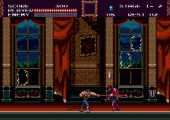
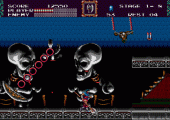
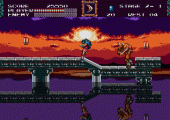
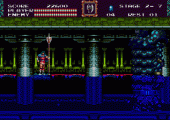
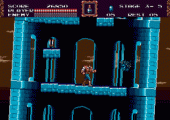
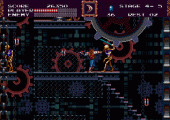
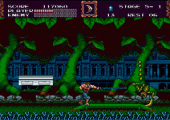
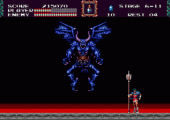
I always thought the graphics looked really good for a Castlevania game. TMNT:Hyperstone Heist, Castlevania:Bloodlines, & Tiny Toons were excellent Konami titles for Genesis. I still play all 3 quite frequently.
Judged solely on its gameplay, this is probably my favourite 16-bit Castlevania. Controls are tight and each character offers a different type of challenge, enemy AI and game speed is noticeably improved over SCIV, and the difficulty curve is smoother than in RoB. It’s a bit strange how one of the levels is a good bit longer than the others, and the buildup towards the final showdown isn’t very well executed which might upset purists more than it did me. The audiovisual experience is solid, but could’ve been much better as we’ve seen from other Konami games.
The game that shows how half-assed Konami treated the Mega Drive most of the time.
This one could have been a real blockbuster had the controls been tweaked more… and had Konami not placed a color-blind person in the graphics department. Sometimes the detailed, nice pixel art is really destroyed by an atrocious choice of colors.
There was a color patch in the works that has been canned since; a beta should still be available at Eidolon´s Inn though. The parts it does affect look soooo much better.